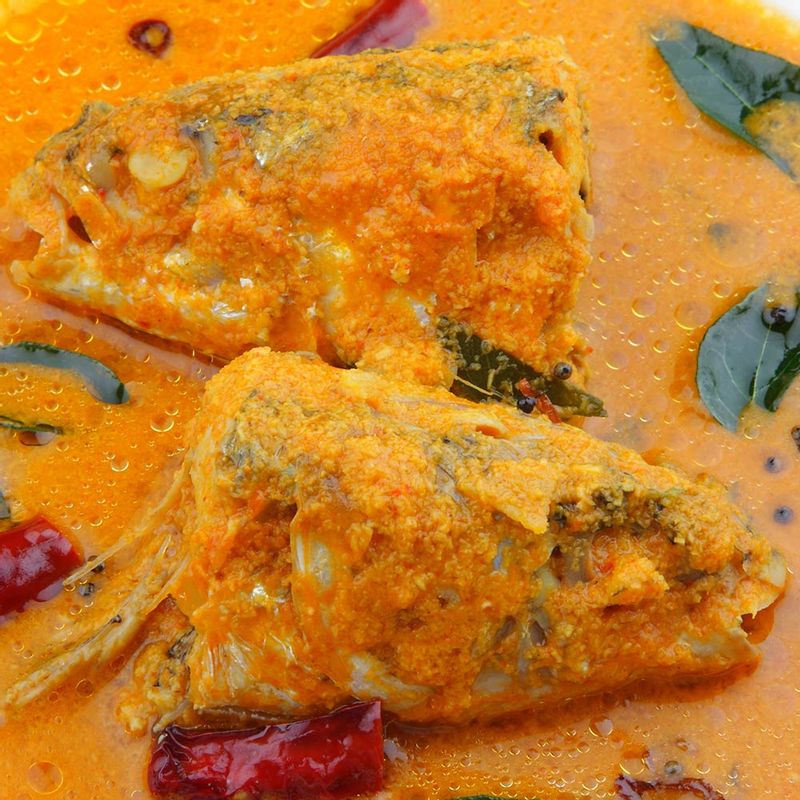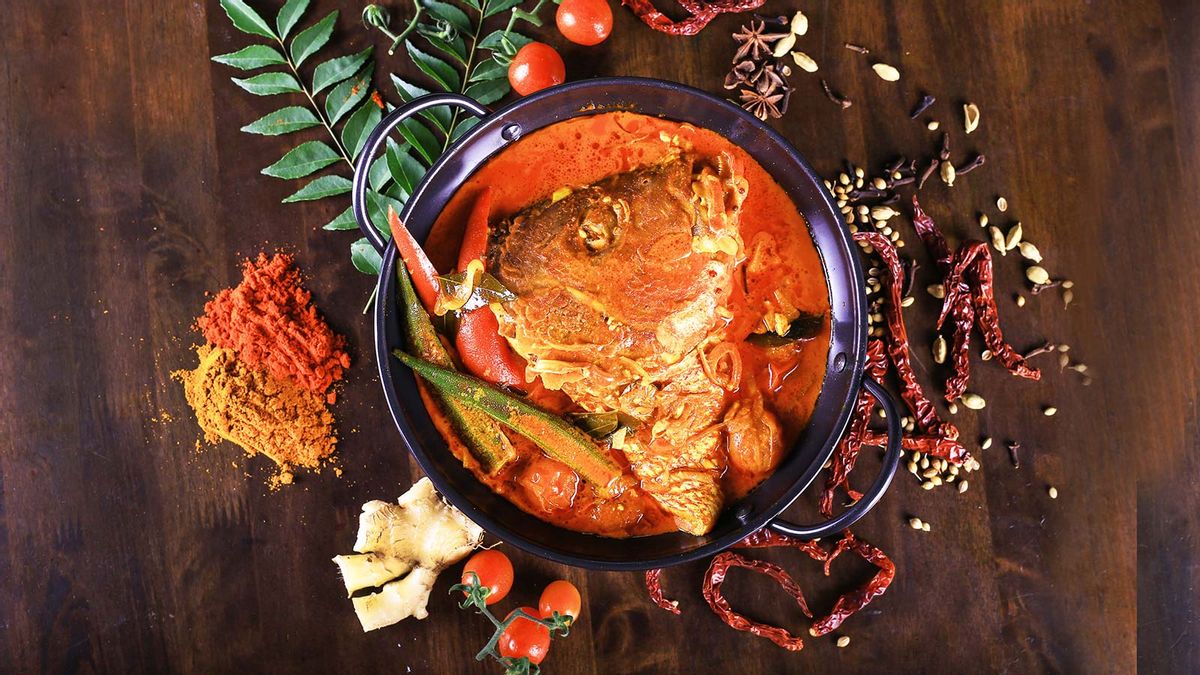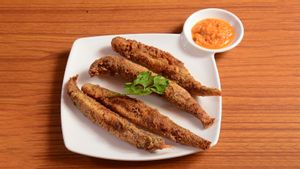Growing up in a Bengali home, birthdays meant an elaborate lunch comprising a range of traditional delicacies. Of the few binding features of this celebratory meal, it was the mammoth fish head (usually of a Rohu or Katla) cooked in a rich, unctuous gravy, served on a bell metal plate that remained untouched. It made me squeamish. Typically, an older cousin claimed it.
He sat with it for hours, breaking it down systematically, sucking out the gelatinous brain matter, picking at the moist, dense and flaky chunks of flesh from the cheeks, and finally chomping on the umami-rich eye balls bringing to an end the elaborate ritual. One birthday I conquered my reservations and decided to give it a go myself. It was an epiphany that changed the way I ate fish, forever. It also meant, at least to my Bengali family, I had evolved into a serious fish eater.
Of course, Bengalis aren’t the only fish head lovers in the country. The Odias love their Machha Munda, and the Assamese relish there Masor Matha. Again, down south, the fish head is cooked into rich, spicy curries—the recipes vary from one region to another. However, few communities, use the fish head as passionately and prolifically as the Bengalis.

Gastro-politics of a fish head
The prudent Bengali kitchen is traditionally known for its staunch no-waste policy, and the fish is no exception. No part of the fish is wasted. The head, however, is especially favoured. The Bengali love for fish head or machher muro, as it’s locally called, is manifest not only in the numerous dishes made with it but also in the fish head’s symbolic and cultural conventions.
In riverine Bengal, fish—a prime source of sustenance—is a symbol of plenty and the fish head propitious or ‘Shubho’, integral to ceremonial and celebratory meals. On the other hand, the fish head, as food historian Chitrita Banerji aptly wrote once, is “the ultimate indicator of preferential treatment for the recipient” or even a marker of family hierarchy, often reserved for the family patriarch, the pampered son or the visiting son-in-law.
Interestingly, Satyajit Ray’s 1963 masterpiece Mahanagar, when the film’s female protagonist Arati becomes the family’s sole bread-earner, her mother-in-law is seen serving her the fish head for her morning meal before leaving for work. In a clever exploration of Bengali middle-class gastro-politics, Ray uses the fish head to subtly depict the shift in the power dynamics within the family.
A matter of taste
However, the Bengali love for the fish head is primarily a matter of taste. A veritable flavour bomb, the delicious brain matter transforms a dish with its unctuous richness. Besides, the muro is rich in nutrients like Omega-3, vitamin A and iron, and in the Bengali universe, it is known to foment brainpower. “Muro khele buddhi baare” mothers and grandmothers would insist.
Bengali kitchens have been cooking with a fish head for a long, long time. Medieval Bengali literature such as the Mangalkavyas, a genre of lyrical prose composed by multiple authors over a few centuries, mention numerous dishes cooked with fish head—rohu fish head cooked with green bananas or lentils, vegetables cooked with fish head, the head of the shol fish (from the snakehead family) cooked with eggplants and more. Variations of these dishes are still cooked in Bengali kitchens.
A perennial favourite in Bengali homes is the machher muro diye moong dal—deep-fried fish head is simmered with roasted moong dal cooked with aromatic whole spices like cardamom, cloves, cinnamon and ginger. Besides, there’s the chhanchra—a delightfully spicy, slightly mushy, hodgepodge typically made with pui or malabar spinach and a medley of other vegetables such as pumpkin and brinjal, to which fish head, deep-fried and chopped up, is added towards the end. These dishes are often part of wedding feasts, served typically for lunch to friends and family—with a large crowd to feed, no part of the fish must go waste.
A trip around the subcontinent
Typically head of large fish like Katla, Rohu, Bekti or Hilsa go into such preparations. The fish head is also cooked with cabbage or bottle gourd to make dry, mushy curries. And then there’s the indulgent Muri Ghonto, a pulao-like dish cooked with fish head and aromatic rice, with warm spices and generous lashings of ghee. Slightly different versions of these dishes are equally popular in Odia kitchens. “The Odias love their machha munda chhencheda typically cooked with poi and mudhi ghonto,” says food blogger Barnali Rath.
“In Assam, the fish head is cooked with various vegetables, lentils or khar,” says chef Kashmiri Barkakati Nath. “When Xewali flowers are in season, we cook the flowers with masor matha too,” adds Nath. While in Bengal and Odisha, the fish head is typically cooked with split yellow moong dal, in Assam fish head is cooked with Mati Dali (black gram or urad dal). “It’s quite the delicacy reserved for guests in the state,” says Nath, where it is a mark of respect to be served the upper portion of the fish.
Across the country, in Konkani Muslim kitchens the especially fleshy head of the mammoth ghol fish is a coveted delicacy. “We make quite a few dishes with fish head or bagar as it’s called in the local language,” says Mumbai-based home chef Shabana Salauddin who serves up her community’s cuisine through her home dining service called Ammeez Kitchen.
There’s the pheeka salan—a light soupy fish head curry flavoured with green chillies, garlic, coriander-cumin powder and curry leaves, and given a silken finish with coconut milk. “We also cook fish head in a rich gravy made with grated coconut, mint and coriander that we call Halduni. It is typically served with Narli Dhan (coconut rice) topped with ghee,” says Salauddin.
In Pathare Prabhu kitchens too every part of the Ghol fish—head, tail and central bone—is cooked and eaten. “It is typically cooked as a slightly gelatinous and flavourful stew, somewhat akin to a paaya soup, called Bhujna,” says Soumitra Velkar, a champion of the community’s cuisine. The particularly strong flavour of the ghol head makes dish something of an acquired taste. “It is no longer as popular as it used to be when nose-to-tail eating was the norm,” Velkar says.
An interesting fish-head based dish typically attributed to the Goan Hindu community is the Kalputi or Kalputti—a dry, stir-fry of sorts made with onions, garlic, green chillies and grated coconut along with a few spices and kokum for a touch of tang. In her book, The Fish Cookbook, Megha Patil, on the other hand, writes about the Bangdachey Kalwan, where the fish head is cooked in a tangy tamarind curry. Again, in Kerala, the fiery Meen Thala Curry is a toddy shop favourite. In fact, the origins of the feted Singaporean fish head soup is often traced to this Kerala speciality, said to have been imported to the country by immigrants from the region.
Kolkata-based food-blogger and home cook Debjani Chatterjee Alam, talks about yet another unique dish called the Bhangachora Shukto. “Unlike the usual shukto (a light, slightly bitter mixed vegetables dish) this dish has no bitter element,” says Chatterjee Alam. An assortment of veggies like potatoes, brinjal, green banana, ridge gourd, etc., are cooked with fish head, shrimp and other varieties of small fish to make a slightly mushy curry, predominantly flavoured with radhuni or wild celery seeds. This very closely resembles Jhol’er Bannyon—a light curry made with banana stem, pumpkin, unripe bananas and ash gourd, fish heads and some shrimps that food anthropologist and consultant Pritha Sen tried during Durga Puja in Kolkata. The dish is served up as part of the Bhog to the Goddess.
Another popular dish of East Bengali origin is the Ilish machher matha diye kochu shaag, Hilsa head cooked with colocasia greens. “The Hilsa head is also used to make a tok or ambol, a slightly runny chutney like curry made with tamarind and a little jaggery—a dish popular in some parts of West Bengal,” says Chatterjee Alam. “In fact, there is such an amazing variety of fish-head based dishes that it’s possible to construct an elaborate, multiple-course meal around the ‘muro’,” she adds. That would be a meal no Bengali would ever object to. And while they are at it, they might as well hum...
Fish heads, fish heads
Roly-poly fish heads
Fish heads, fish heads
Eat them up, yum




